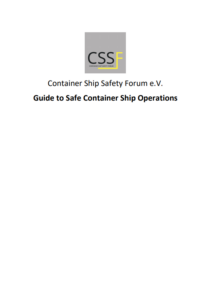The industry association Container Ship Safety Forum (CSSF) published its first Guide to Safe Container Ship Operations to improve the existing safety measures, providing practices and procedures for safe container ship operations.
The Forum highlights that the document does not include security, environmental or crew welfare issues, expect in the cases that there are direct safety implications. Also, the guide aims to be ambitious and raise awareness in safety standards within the container sector.
During the SAFETY4SEA Megabox Forum, the participants discussed about key challenges of containerships and discussed about contributing factors that increase risk of casualties onboard this type of vessels and the frequency of containership fires, suggesting preventive actions and best practices, while also focused on why the human element is being considered as a major contributing factor in the chain of events leading to a casualty.
The Guide consists of eight chapters. In essence:
#Chapter 1
The chapter focuses on policies and management commitment; The company should implement policies and procedures that contain clear leadership and commitment from the highest levels of management to achieve the company’s performance objectives.
#Chapter 2
The chapter focuses on personnel (shore-based and seagoing); The company should have procedures in place to ensure that the management of the fleet is fully supported by shore-based personnel who are competent to carry out their duties and responsibilities.
#Chapter 3
The chapter is about safety management; The company should have a competent SMS that promotes the company’s safety goals, also identifying the most significant risks to crew members or others who may work on board the ship or be affected by shipboard activities. The SMS should promote learning from incidents to achieve continual improvement in the company’s safety performance.
[smlsubform prepend=”GET THE SAFETY4SEA IN YOUR INBOX!” showname=false emailtxt=”” emailholder=”Enter your email address” showsubmit=true submittxt=”Submit” jsthanks=false thankyou=”Thank you for subscribing to our mailing list”]
#Chapter 4
The chapter focuses on navigation and bridge management; The company should have formal procedures ensuring that a vessel can be safely voyaged. The procedures should be sufficiently comprehensive to provide guidance on how the company’s expectations will be met.
#Chapter 5
The chapter is about mooring, anchoring and towing operations; The company should have formal procedures in place to ensure that mooring, anchoring and towing operations are effectively and safely managed.
#Chapter 6
The chapter focuses on cargo operations; The company should implement formal procedures to ensure that cargo is safely loaded, stowed, secured and discharged. The procedures should be written to ensure that appropriate equipment is provided and maintained to facilitate the safe carriage of cargo and that the officers responsible for cargo operations are adequately trained and competent to carry out their tasks and responsibilities.
#Chapter 7
The chapter is about maintenance and reliability; All vessels under the company should be operating safely, efficiently and reliably. Maintenance and reliability procedures should include guidance on the identification and maintenance of critical and non-critical equipment, periodic checks, tests and inspection, overhaul and performance monitoring.
#Chapter 8
The chapter focuses on emergency preparedness procedures to ensure that all companies are capable to respond to emergency situations involving managed vessels. The procedures must include plans to prepare for emergencies and a schedule for drills and exercises.
For more information on the Guide, click on the PDF herebelow































































